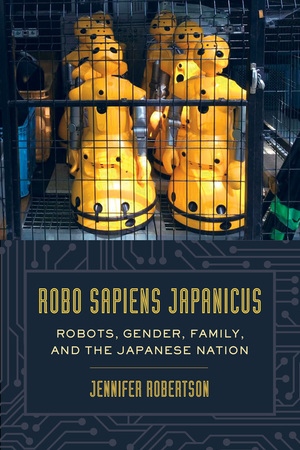Robo Sapiens Japanicus: Robots, Gender, Family, and the Japanese Nation by Jennifer Robertson, Berkeley, CA: University of California Press, 2017, ix + 260 pp., ISBN: 9780520283206.
Felix Borthwick (PhD student, Graduate School of Interdisciplinary Information Studies, the University of Tokyo)

Table of Contents
List of Illustrations
Acknowledgments
Author’s Notes
1. Robot Visions
2. Innovation as Renovation
3. Families of Future Past
4. Embodiment and Gender
5. Robot Rights vs. Human Rights
6. Cyborg-Ableism beyond the Uncanny (Valley)
7. Robot Reality Check
Notes
Bibliography
Index
Anthropology is, by definition, the study of human beings. Yet while the study of diverse human cultures has long formed the base of anthropological research, recent disciplinary trends have seen anthropologists expanding their analytical frame to consider the relationship between human beings and non-human entities. This tendency is evident in the growing body of literature on technological coexistence, i.e. the relationship between human beings and non-organic entities. In the context of Japan studies, Jennifer Robertson’s Robo Sapiens Japanicus contributes to this discussion through its examination of the lived relationship between robots and humans in twenty-first century Japan.
Over the course of the book’s seven chapters, the author explores various aspects of technological coexistence via her analyses of robot-related media texts and discourses, her ethnographic interactions with robots and, of course, the physical bodies of the robots themselves. Following an introductory chapter that briefly covers the material and discursive history of robots in Japan, Robertson devotes two chapters to a discussion of the conservative family ideologies embedded in Innovation 25, a 2007 government proposal for a robotized society. Chapter Four shifts this discussion to the robots themselves, where Robertson argues that roboticists invest both the depictions of robots and the physical bodies of robots with a naturalized sex/gender system. Chapter Five adopts a broad focus on human rights discourse in Japan to reveal how ‘Japanese’ robots’ accommodation within this discourse reflects the difficulty of incorporating of those perceived as ‘non-Japanese’ into a hegemonic framework of Japanese cultural identity. Similarly, Chapter Six employs the concept of “cyborg-ableism” (pg. 27) to discuss how the functionalities allowed by robotic prosthetics uphold an ideal of the non-disabled body. The epilogue in Chapter Seven then closes the text with a sobering account of the very limited capabilities of real-life robots under contemporary technological constraints, which contrast starkly with the utopian ideals embedded within Japan’s robotic discourse.
The book’s primary thesis – that robots and their depictions are conditioned by the specific context of their “national cultural, social institutional and family structures” (pg. 26) at their point of creation, with their manifestation serving to reify and reinforce the dominant ideologies of these structures – is unlikely to raise scholarly brows. Much of Robertson’s argument is built on the analysis of media texts, so it is unsurprising to learn that these texts reflect dominant social ideologies (especially those produced by the Japanese government). The robotic bodies in Robertson’s analysis become, by extension, cultural texts or products themselves, so it is easy to grasp how they too reflect these ideologies. The thesis offers more room for intellectual provocation when Robertson links the reinforcement of reactionary ideologies with discourses of technological innovation, but this idea is not the core argument of the book and, as a result, remains underdeveloped.
Robertson builds this thesis through addressing multiple topics (disability, human rights, sex and gender, family, the state) while employing different theoretical concepts in each chapter. It is in the application of these concepts to robotic bodies that we find the author at her most challenging. For instance, Robertson’s discussion of the manifestation of sex and gender in robots draws on Suzanne Kessler and Wendy McKenna’s idea of “cultural genitals” (pg. 99) – i.e. the attribution of gender through cultural markers that evoke genitalia – and is the most provocative example of this creative theoretical exploration.
Though the thematic and theoretical diversity of Robertson’s study offers multiple insights into the dimensions of robot-human coexistence in contemporary Japan, it also reveals a methodological blurriness common to anthropological studies. Robertson freely claims that her study “[does not] subscribe to a trending “theoretical” approach” (pg. 31); rather, she adopts an “eclectic, genre-crossing” orientation (pg. 31) that incorporates a diverse range of research materials (texts, images, fieldwork, interviews) and levels of analysis (close reading of texts, ethnographic thick description). This lack of cohesiveness leaves the text without a central theoretical argument. All too often it feels like an impressionistic collection of observations that may be linked thematically by their focus on robots, but which never collectively reveal the theoretical importance of this study.
Robertson’s ethnographic passages are, at once, the most interesting and least developed parts of the text. There are only two instances of sustained ethnographic description in the entire study: her trial of a Cyberdyne robot exoskeleton in Chapter Six and her experiences at the prototype “Robot City” (pg. 178) Wabot House. These episodes in fact offer the most visceral examples of the discrepancy between the technological ideals invested in robots and the limitations of present-day technological realities, which is another central theme of the text. If, in her analysis of robot-related media texts, Robertson had given further focus these texts as they were being used in specific social contexts (a discussion which does emerge in Chapter Four’s discussion of gendered magazine covers), the ethnographic element of the study would be sharpened and the text as a whole would feel more unified.
The treatment of robot bodies and robot-related media as cultural texts reveals a tendency to reify or essentialize certain subjects that is present throughout the book. Chiefly, Robertson’s analysis paints robots as entities whose form and function are determined by the structural patterns of inequality that ensnare their creators. This leaves little room for a discussion of agency as it emerges in the robots themselves, so the broader issue of technological coexistence as humans and robots living with each other is left unexplored. Japan’s Prime Minister Abe appears as another instance of this, invoked frequently in the text as a manifestation of state authority. Robertson’s emphasis on the top-down character of this authority presents a simplified scheme of political behavior in Japan, a topic which itself is ripe for further ethnographic scrutiny. It is also worth noting that the author’s discussion of religion in the final chapter rests on generalizations made about the role of Buddhism and Shinto in Japanese society, all concepts which deserve further unpacking to reveal their contested meanings.
Naturally, some degree of simplification or generalization is unavoidable in anthropological work. There is a pressing need to convey your research to anthropologists working in different geographic fields, as well as an anthropological drive to establish the existence of cultural differences. Robertson’s use of essentialized or reified concepts therefore neatly underlines the inherent difficulties in balancing generalized and nuanced analyses of research subjects in anthropology.
But discussions of robotic agency may ultimately be inconsequential, as Robertson highlights in her repeated emphases on the temporal moment in which the book is written. She combines two lines of analysis: her examination of the aspirations invested in textual depictions and justifications of robotic life and her disappointing real-life interactions with the limited functions of physical robots from the late 2000s onward. The “reality check” (pg. 175) offered by the discrepancy between the technological ideals (or desires) present the former and the awkward technological realities of the latter serves only to intensify the unreality of the ideal itself. In this sense, there is actually not much space for agency to emerge, as technological constraints still have yet to catch up with the utopian functions stressed in the many voices with which Robertson engages.
Robo Sapiens Japanicus will survive as a provocative look at the gap between utopian technological dreams and frail technological realities in the first two decades of the twentieth century. Japan studies specialists in sub-fields like politics and religion may find fault with her uncritical approach to certain topics and more ethnographically inclined anthropologists may balk at the lack of a rigorous methodological or theoretical foundation. Nevertheless, the diversity of topics and research materials should give the general reader a strong grasp of the multiple possibilities and limitations inherent in contemporary human-robot relations.
Publisher's website: https://www.ucpress.edu/book/9780520283206/robo-sapiens-japanicus



